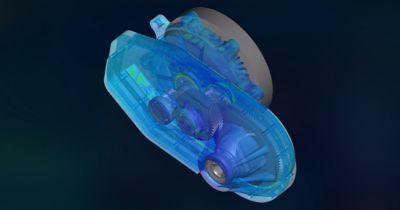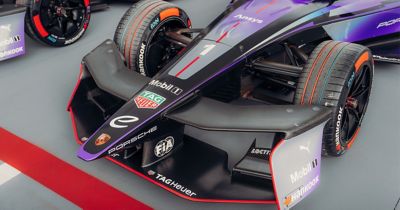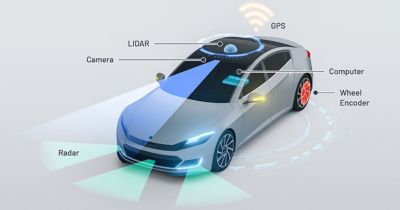-
United States -
United Kingdom -
India -
France -
Deutschland -
Italia -
日本 -
대한민국 -
中国 -
台灣
-
Ansys는 학생들에게 시뮬레이션 엔지니어링 소프트웨어를 무료로 제공함으로써 오늘날의 학생들의 성장을 지속적으로 지원하고 있습니다.
-
Ansys는 학생들에게 시뮬레이션 엔지니어링 소프트웨어를 무료로 제공함으로써 오늘날의 학생들의 성장을 지속적으로 지원하고 있습니다.
-
Ansys는 학생들에게 시뮬레이션 엔지니어링 소프트웨어를 무료로 제공함으로써 오늘날의 학생들의 성장을 지속적으로 지원하고 있습니다.

For decades, car companies have boasted about their safety, with commercials depicting a car crashing into a wall and a test dummy coming out more or less unscathed. But with electrification and autonomy hot on the minds of automotive engineers and consumers, passenger and pedestrian safety is of utmost importance.
While physical crash dummies and their digital counterparts will always be in use, many automotive makers are starting to use human body models. Increasingly sophisticated safety systems and new application areas require higher-fidelity models than the ones currently on the market. Plus, several safety-certifying bodies around the world are working on initiatives to establish virtual product certification using qualified human body models. This is where the Ansys Hans Human Body Model for Ansys LS-DYNA nonlinear dynamics structural simulation software comes in.

The Ansys Hans Human Body Model provides a more accurate approximation of people than the crash test dummies of the past.
Dummies but Not Dumb
Crash test dummies have been making transportation safer since the late 1940s, when they were first used by the U.S. Air Force to test pilot restraint and ejection systems. The Air Force previously used real people until safety tests became too rigorous for humans to safely participate in. After seeing the success that the Air Force had, auto manufacturers started creating their own versions.
Different iterations of test dummies were created to suit each maker’s needs, but GM’s Hybrid III dummy became the industry standard for frontal impact and airbag safety compliance testing in 1997. All versions of test dummies were designed to mimic the human body as closely as possible — with similar weight, size, and proportions to that of an average adult male — but the Hybrid III did it best. Equipped with accelerometers, potentiometers, and load cells, automakers could measure the acceleration, deflection, and forces that people experience during car crashes.
But as technology advanced, researchers acquired more data and a greater understanding of the human body, and automotive safety requirements increased to reflect this new knowledge. Thus, new and improved crash test dummies like WorldSID and THOR have surfaced. The latest evolution of crash testing involves virtual human body models.
The Ansys Hans Human Body Model is a passive model targeted for any kind of explicit impact simulation, from car crashes to sports injuries.
Hi, I’m HANS
Hans is a high-fidelity human body model that provides more accurate approximation of people than traditional test dummies. He is a passive model targeted for any kind of explicit impact simulation, from car crashes to sports injuries. The first release of the Hans model focuses on the musculoskeletal system, with future releases fine-tuning inner organs, adipose tissue, and joint and muscle movements. Hans is based on a 30-to-40-year-old man who weighs about 77 kg (170 lbs.) and is 176 cm (5 ft., 9 in.) tall. The model organization consists of five layers:
- Skeleton: includes cortical and trabecular bone
- Connective tissue: includes ligaments, joint capsules, and cartilage
- Muscles and tendons: all modeled as individual parts
- Inner organs and brain: all individually discretized
- Adipose tissue and skin: includes adipose tissue, dermis, and epidermis
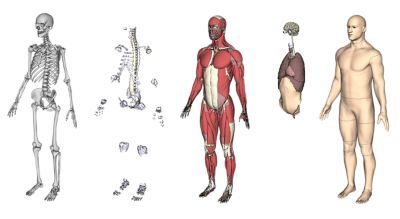
The different model layers in the Ansys Hans Human Body Model (from left to right): skeleton, connective tissue, muscles and tendons, inner organs and brain, and adipose tissue and skin
Physical crash testing is very expensive, and manufacturers can see what happens only on the outside of the dummy, with limited knowledge of the internal reactions. “But with virtual crash simulation, we now have our Hans Human Body Model that we can put in cars and look at what’s going on inside the body in terms of bones, muscles, and tissue,” says Alexander Gromer, senior manager application engineer at Ansys.
This chest impact shows the effect on the muscles.
The Brains of the System
While it’s important to account for injuries to the entire body, the brain is of particular importance for any high-impact situation. Broken bones can heal, but the long-term consequences of brain trauma — especially repeated injuries in settings such as sports — can have detrimental effects. Modeling the brain and how it moves in a skull during impact enables car manufacturers to see if a fender bender could result in a simple headache or something much more nefarious.
“If you think of our head like an egg, our skull is the eggshell, our brain is the yolk, and cerebrospinal fluid is the egg white,” says Skylar Sible, an application engineer on the Hans team. “I’m tracking 12 points in the brain to see how the brain shifts relative to the skull in an effort to model the cerebrospinal fluid better.”
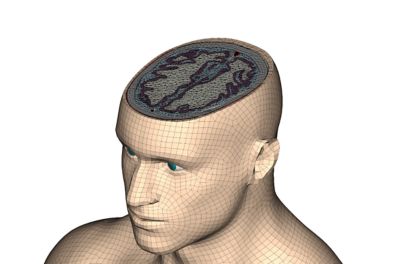
Hans brain model (left) and brain impact simulation in Ansys LS-DYNA nonlinear dynamics structural simulation software (right)
Safety First
“The goal of Hans is to provide everything you would need for any kind of safety application,” says Gromer, “whether that be someone sitting in a car crash event or pedestrian safety analysis.”
Using digital models reduces the number of physical car crash tests that automakers need to perform, which saves time and money. Engineers can see what happens virtually during a crash, make tweaks, and run the test again without having to physically prototype every single car part. And with all that data, car makers can make better, safer, more efficient cars in the years to come. “I don’t think it will be possible to get a five-star safety rating without doing these kinds of simulations by the end of this decade,” says Gromer.
And automotive is just the beginning. The Hans team plans to improve the model’s capabilities to cover load cases for defense, sports, and healthcare next.
Learn More
Learn more about how the Hans model for LS-DYNA software can help with your simulation needs.
Just for you. We have some additional resources you may enjoy.
“With virtual crash simulation, we now have our Hans Human Body Model that we can put in cars and look at what’s going on inside the body in terms of bones, muscles, and tissue.”
— Alexander Gromer, senior manager application engineer, Ansys
The Advantage Blog
The Ansys Advantage blog, featuring contributions from Ansys and other technology experts, keeps you updated on how Ansys simulation is powering innovation that drives human advancement.











